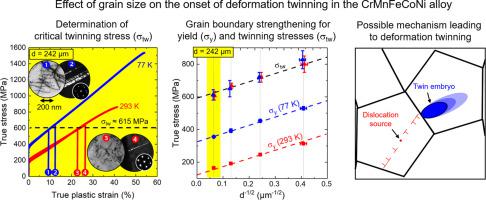International Journal of Plasticity ( IF 9.4 ) Pub Date : 2023-05-25 , DOI: 10.1016/j.ijplas.2023.103651 Christian Wagner , Guillaume Laplanche

|
While the impact of grain boundary strengthening on dislocation slip is particularly effective in the equiatomic CrMnFeCoNi high-entropy alloy (HEA), its effect on deformation twinning remains unclear. To better understand how a grain size reduction affects the onset of deformation twinning and the work hardening behavior of the CrMnFeCoNi HEA, chemically homogeneous, nearly untextured, and single-phase face-centered cubic alloys with different grain sizes were investigated. Tensile tests were performed at 293 and 77 K and interrupted at different strains followed by systematic transmission electron microscopy observations. In all cases, deformation twinning occurs above a critical stress that is independent of temperature. This uniaxial twinning stress decreases from ∼785 to ∼615 MPa when the grain size increases from 6 to 242 µm, respectively, following the Hall-Petch equation. The resistance of the grain boundaries against slip and twinning is found to be nearly identical (Hall-Petch slope: ∼500 MPa·µm1/2) but the twinning stress extrapolated to infinite grain size (592 ± 30 MPa) is larger than the uniaxial friction stress against dislocation glide at 293 and 77 K (130 and 320 MPa, respectively). Deformation twinning at 77 K is found to sustain a high work hardening rate when it is triggered in a plastic regime dominated by planar glide of dislocations. In contrast, it does not significantly contribute to the work hardening rate at 293 K when dislocation cells have already formed and the dislocation mean free path is smaller than the mean twin spacing.
中文翻译:

晶粒尺寸对等原子态 CrMnFeCoNi 高熵合金临界孪晶应力和加工硬化行为的影响
虽然晶界强化对位错滑移的影响在等原子 CrMnFeCoNi 高熵合金 (HEA) 中特别有效,但其对变形孪晶的影响仍不清楚。为了更好地了解晶粒尺寸减小如何影响变形孪晶的开始和 CrMnFeCoNi HEA 的加工硬化行为,研究了具有不同晶粒尺寸的化学均匀、几乎无织构和单相面心立方合金。拉伸试验在 293 和 77 K 下进行,并在不同的应变下中断,然后进行系统的透射电子显微镜观察。在所有情况下,变形孪晶都发生在与温度无关的临界应力之上。当晶粒尺寸从 6 µm 增加到 242 µm 时,这种单轴孪晶应力分别从 ~785 MPa 降低到 ~615 MPa,遵循 Hall-Petch 方程。发现晶界对滑移和孪晶的抵抗力几乎相同(Hall-Petch 斜率:~500 MPa·µm1/2 ) 但外推到无限晶粒尺寸 (592 ± 30 MPa) 的孪晶应力大于 293 和 77 K(分别为 130 和 320 MPa)的位错滑移的单轴摩擦应力。发现 77 K 变形孪晶在以位错的平面滑移为主的塑性状态中被触发时,可以维持高加工硬化率。相反,当位错单元已经形成并且位错平均自由程小于平均孪晶间距时,它对 293 K 时的加工硬化率没有显着贡献。











































 京公网安备 11010802027423号
京公网安备 11010802027423号